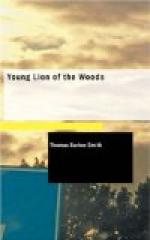It was snowing when he fell, and when he became conscious of his situation, he found himself covered with an inch or more of snow, and his head and face badly cut and bruised. On all four he crept to the British outposts with the blood streaming from a cut in his leg and one on his face. At last he reached the lines, more dead than alive. Paul received a cold from which he never recovered.
In the morning he crawled out in search of the ring, thinking it might be of some value. He was enabled to find the place where he had fallen by retracing his steps and seeing the blood on the snow in spots here and there. It had stopped snowing soon after he recovered consciousness, consequently it was not difficult next morning to find out the spot where he had received his injuries. The sun was shining brightly, and as he kicked away the snow after hunting about for an hour or so, his eye caught something shining brilliantly. He picked it up. It was a ring. He put it into his pocket and returned. He knew he had seen the ring before. He put it in an inside pocket of his coat and sewed it in, fearing he might otherwise loose it.
The Indian for a long time was unfitted for active duty. He made his home sometimes at the garrison and sometimes with the tribes of Indians in the neighborhood.
When General Burgoyne, in June, 1777, advanced from Canada into the New England States, Paul Guidon attached himself to one of the officers of the expedition. This officer was afterward killed and Paul was captured by the Americans and sent a prisoner to Boston, and at that place detained for some months.
At length he managed to make his escape. He wandered for weeks in the woods and along the paths, and at last struck the Nova Scotia boundary and continued on until he reached the vicinity of Fort Frederick. There he remained for a short time visiting the scenes and places of other days. He then set out once more for Quebec, and arrived there in September, 1778, where he remained till the close of the war. In September, 1780, he was united in marriage with a handsome young Chipewayan squaw. Paul Guidon was loved and admired by most of the Indians of the Quebec district, and never wanted for a home amongst them.
His wife was of medium height, her face was handsome, and her features clean-cut, as they are seen in Greek statuary. She was as brown as some statues are. Her eyes were of the deepest and brightest black, they were quick and piercing as arrows sent to their mark.




